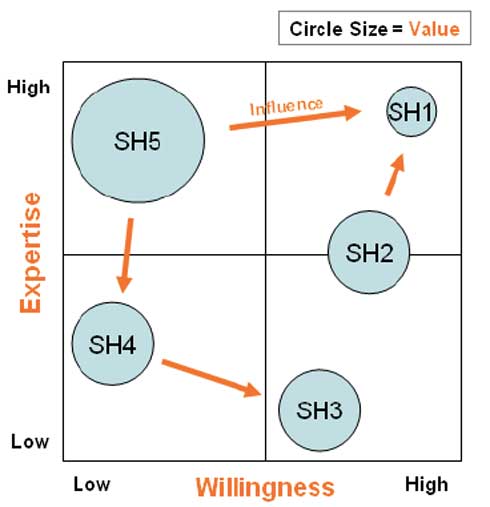Are you curious about the meaning of the term stakeholder engagement in business? Find all its official definitions below, as well as why it is important and what actions can you take to make an effective engagement with your stakeholders.
Definitions of Stakeholder Engagement in Business
Stakeholder Engagement Definition in Business
Stakeholder engagement is the process by which companies communicate and get to know their stakeholders. By getting to know them, companies are able to better understand what they want, when they want it, how engaged they are and how the companies’ plans and actions will affect their goals. Furthermore, they can improve their communication and rethinking their strategies and operations, having long-term benefits such as brand reputation or first mover advantage.
Other Official Stakeholder Engagement Definitions in Business:
Official Definition of Stakeholder Engagement in Business according to the AccountAbility 1000 Stakeholder Engagement Standard
Stakeholder engagement is the process used by an organization to engage relevant stakeholders for a clear purpose to achieve agreed outcomes. It is now also recognized as a fundamental accountability mechanism since it obliges an organization to involve stakeholders in identifying, understanding and responding to sustainability issues and concerns, and to report, explain and answer to stakeholders for decisions, actions, and performance. Stakeholder engagement is the process used by an organization to engage relevant stakeholders
Official Definition of Stakeholder Engagement in Business according to Stakeholder Resource Associates
Engagement is an umbrella term that covers the full range of an organization’s efforts to understand and involve stakeholders in its activities and decisions. Engagement can help organizations meet tactical and strategic needs ranging from gathering information and spotting trends that may impact their activities, to improving transparency and building the trust of the individuals or groups whose support is critical to an organization’s long-term success, to sparking the innovation and organizational change needed to meet new challenges and opportunities.
Definitions of Stakeholder in Business

Definition of Stakeholder in Business
Stakeholders are internal or external groups that can affect, directly or indirectly, the activities and performance of an organization, or vice-versa.
Other Stakeholder Official Definitions in Business
Stakeholder Official Definition in Business according to the AA1000 Stakeholder Engagement Standard
Stakeholders are those groups who affect and/or could be affected by an organization’s activities, products or services and associated performance. This definition does not, therefore, include all those who may have knowledge of or views about the organization. Organizations will have many stakeholders, each with distinct types and levels of involvement, and often with diverse and sometimes conflicting interests and concerns.
Stakeholder Official Definition in Business according to the International Finance Corporation
Stakeholders are persons or groups who are directly or indirectly affected by a project, as well as those who may have interests in a project and/or the ability to influence its outcome, either positively or negatively. Stakeholders may include locally affected communities or individuals and their formal and informal representatives, national or local government authorities, politicians, religious leaders, civil society organizations and groups with special interests, the academic community, or other businesses. The “stake” that each of these different individuals or groups has in a project or investment will vary. For example, there may be people directly affected by the potential environmental or social impacts of a project. Others may be resident in another country altogether, but wish to communicate their concerns or suggestions to the project company. Then there are those who might have great influence over the project, such as government regulators, political or religious leaders, and others active in the local community. There are also stakeholders who, because of their knowledge or stature, can contribute positively to the project, for example, by acting as an honest broker in mediating relationships.
Examples of Stakeholders
Typical Primary Stakeholders in Business: investors, employees, customers, suppliers, business and local communities.
Typical Secondary Stakeholders in Business: competitors, trade associations, media, labor unions, civil society organizations and NGOs, governments, and policymakers.
Why is stakeholder engagement important?
- It gives companies social license to operate, expand and innovate;I
- It improves the relationship between companies and their stakeholders;
- It gives companies a positive public image and improves companies’ reputation;
- It avoids costs with litigations or boycotts;
- It helps companies identify emerging trends, have a proactive approach to them and act with a first mover advantage towards their competition.
What methods can be used for stakeholder engagement?
According to AA1000SES2015, there are different levels of stakeholder engagement with different tools to engage that can be used:

- Remain Passive: There is no active communication.
- Methods of engagement: stakeholders do protests, write letters, complain on social media or on the company’s website.
- Monitor: It’s a one-way communication monitored by the company.
- Methods of engagement: media and internet are tracked, as well as other second-hand reports from stakeholders.
- Advocate: It’s a one-way communication from the organization to the stakeholders.
- Methods of engagement: Pressure in regulatory bodies is made, as well as advocacy efforts on social media as lobbying.
- Inform: It’s a one-way communication from the organization to the stakeholders with no invitation to reply.
- Methods of engagement: It is made through bulletins and letters, brochures, reports, and websites. Verbally, speeches, conferences and public presentations can also be done.
- Transact: It’s a limited two-way engagement: performance is monitored according to terms of the contract set.
- Methods of engagement: This is achievable via public-private partnerships, private finance initiatives, grantmaking, and cause-related marketing.
- Consult: It’s a limited two-way engagement where an organization asks questions and stakeholders answer.
- Methods of engagement: It uses methods tools as surveys, focus groups, meetings with determined stakeholders, public meetings or workshops
- Negotiate: It’s a limited two-way engagement where a specific issue or range of issues are discussed with the goal of reaching consensus.
- Methods of engagement: Collective bargaining with workers through their trade unions.
- Involve: It’s a two-way or multi-way engagement: there is learning on all sides but stakeholders and the organization act independently.
- Methods of engagement: This can be done in multi-stakeholders forums, advisory panels, focus groups or online engagement tools, among others.
- Collaborate: It’s a two-way or multiway engagement where learning, decision making and actions are done together.
- Methods of engagement: By making joint projects or joint ventures, partnerships, organizing multi-stakeholder initiatives or using online collaborative platforms.
- Empower: It’s a new form of accountability where some decisions are delegated to stakeholders that now have a role in the organization’s agenda.
- Methods of engagement: It implies integrating stakeholders into the governance, strategy and operations of the company.
How to know who to engage with – Stakeholder Mapping
Starting or re-designing a process of stakeholder engagement can be a long run. If many stakeholders have been profiled, it is important to prioritize them and choose carefully the ones to engage with first. This identification will allow the development of a good engagement strategy plan. But how to know who are the (most important) stakeholders? This turns into easier questions if answered by a process known as stakeholder mapping.
Stakeholder mapping is a collaborative process of research, debate, and discussion that draws from multiple perspectives to determine a key list of stakeholders across the entire stakeholder spectrum.
The definition above was made by BSR (Business for Social Responsibility). They broke the stakeholder mapping process into 4 stages that are as important as the final result and where the knowledge of the people participating adds great value:
1. Identifying: listing relevant groups, organizations, and people.
At this phase, stakeholders that cross the mind of the brainstormers in the room, who are ideally people from different areas of the company, are written down without screening. Here, several questions can be done from multiple perspectives in order to remember who the stakeholders might be: Who has an in impact on our business? Who will be impacted by our new product, activity or expansion? Who do we depend on in order to have our business running?
2. Analyzing: understanding stakeholder perspectives and relevance.
Once there is a list of stakeholders, it is useful to go for a deeper analysis, understanding the relevance of each one of them. Questions like the ones below can be asked:
> Contribution: Does the stakeholder have information, counsel, or expertise on the issue that could be helpful to the company?
> Legitimacy: How legitimate is the stakeholder’s claim for engagement?
> Willingness to engage: How willing is the stakeholder to engage?
> Influence: How much influence does the stakeholder have? (You will need to clarify “who” they influence, e.g., other companies, NGOs, consumers, investors, etc.)
> Necessity of involvement: Is this someone who could derail or delegitimize the process if they were not included in the engagement?
3. Mapping: visualizing relationships to objectives and other stakeholders
The mapping process has to do with choosing two criteria like the ones made above and answering them in a graphic way, organizing and placing stakeholders in their quadrants. See the example below where SH represent different stakeholders and where we can see that SH1 is the stakeholder with higher expertise and more willing to engage.

4. Prioritizing: ranking stakeholder relevance and identifying issues
It is not practical and usually not necessary to engage with all stakeholder groups with the same level of intensity all of the time. Being strategic and clear about a company is engaging with and why, before jumping in, can help save both time and money. In this way, the stakeholders that more often perform HIGH in each axis of the stakeholder mapping graphics should usually be the ones to focus on in first place. Using the example above, if willingness and expertise were the only criteria that mattered, SH1 and SH2, both performing high on the two axes, would be the ones to prioritize. But there are several criteria that can matter and therefore other graphics and analysis that should also be done before jumping into conclusions, considering the materiality topics for the organization as well.
For more information on stakeholder engagement issues, we suggest you take a look into the AA1000 Stakeholder Engagement Standart and the BSR 2012 report.
[Images credits for Shutterstock on stakeholder meeting and AA1000SES2015]